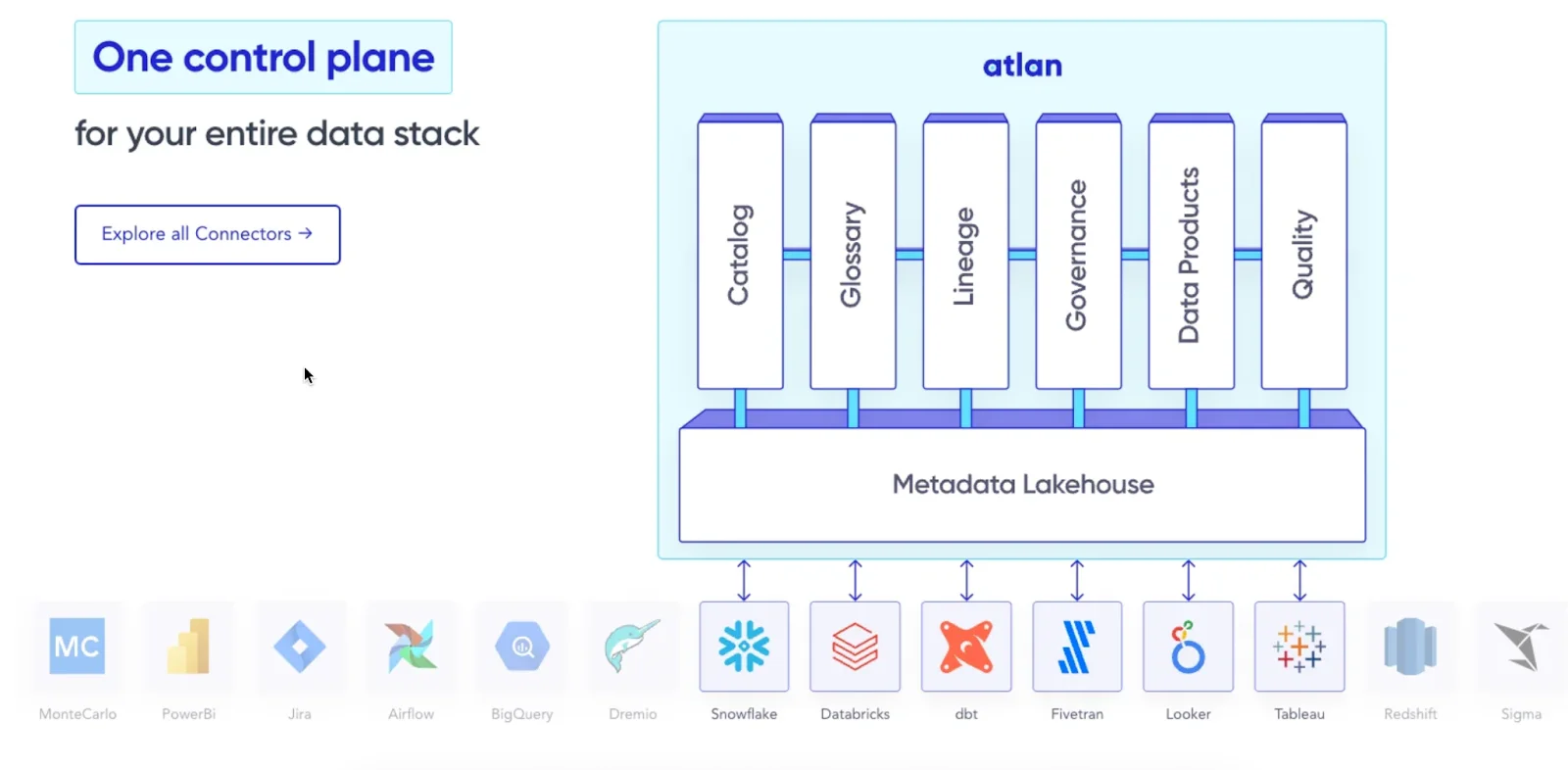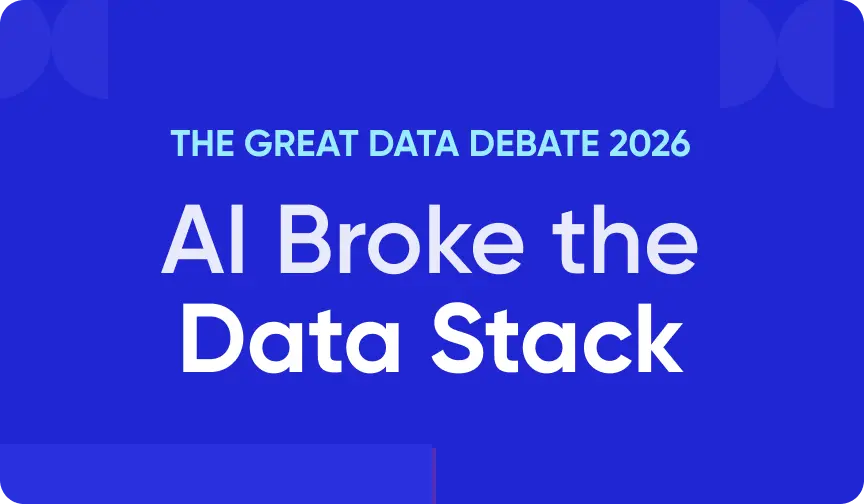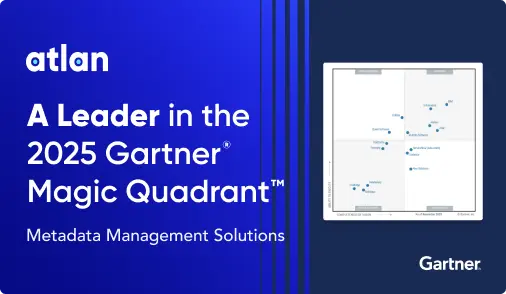Snowflake Data Governance: Native Capabilities, Tooling & The Role of A Metadata Control Plane
Share this article
Snowflake data governance helps organizations meet regulatory compliance requirements while securely managing and controlling data access at scale.
Snowflake’s built-in enterprise-grade capabilities include data quality monitoring, column and row-level security, object tagging, sensitive data classification, access history tracking, and object dependencies.
Scaling AI on Snowflake? Here’s the playbook - Watch Now
Snowflake Horizon further enhances these native capabilities with a unified interface for compliance, security, privacy, interoperability and access. This enables organizations to govern and discover their data, apps, and more within the Snowflake ecosystem.
See How Atlan Simplifies Data Governance – Start Product Tour
This article will explore:
- Snowflake’s native data governance features
- The role of Snowflake’s Horizon Catalog in Snowflake data governance
- Building a metadata-led data and AI control plane for a consistent, end-to-end view of all your assets
- How leading companies across industries are leveraging the Snowflake-Atlan integration to unlock the complete potential of their data estate
Table of contents
Permalink to “Table of contents”- How does Snowflake support data governance?
- How are Snowflake users applying its data governance features?
- What is the role of a metadata-led control plane in enhancing Snowflake data governance?
- How does Atlan enhance Snowflake’s native data governance capabilities?
- How can you unlock the complete potential of Snowflake with Atlan?
- How the Snowflake and Atlan integration benefits customers across industries
- Snowflake data governance: Wrapping up
- Snowflake data governance: Frequently asked questions (FAQs)
- Snowflake data governance: Related reads
How does Snowflake support data governance?
Permalink to “How does Snowflake support data governance?”Snowflake, as the primary data storage and processing layer of the data stack, offers features for data asset discovery, collaboration, and governance—collectively known as Snowflake Horizon Catalog.
The Horizon Catalog helps organizations unlock value from their data by enabling discovery and governance within the Snowflake AI Data Cloud.
“To make it easier for customers to manage and assign tags and policies, Snowflake Horizon offers an intuitive interface that provides an at-a-glance summary of the total objects, tagged objects and protected objects in an account.” - Snowflake’s definitive guide to data governance summarizes the role of Snowflake Horizon
You can leverage features like:
- Data quality monitoring with custom data metric metrics and near-real-time alerts
- Visual data lineage tracking in Snowsight to understand table and column relationships
- Object tagging and automated sensitive data classification for tracking compliance, discovery, and protection
- Dynamic masking using SQL statements or Python UDFs
- Trust Center for monitoring security posture and CIS benchmark compliance
- Natural language search and AI-generated descriptions for tables and columns to improve discoverability
- Preserving privacy with aggregation policies, projection policies, differential privacy, and data clean rooms
- Internal Marketplace for secure data product sharing and collaboration
Read more → Snowflake Horizon Catalog 101
How are Snowflake users applying its data governance features?
Permalink to “How are Snowflake users applying its data governance features?”The above-mentioned Snowflake data governance features have seen increasing adoption as organizations implement unified data governance practices.
According to the Snowflake 2024 Trends Report, Snowflake reported a 70% growth in the application of data governance features across its platform between 2023 and 2024.
This includes advancements in data access controls, tagging, and masking policies, which have enabled organizations to protect sensitive data effectively while still making it accessible for analytical and AI-driven tasks.
“We saw that our users were applying more tags governing access and use of their data, meaning that they were ensuring that necessary audiences could make use of their data while restricting unauthorized user access.” - Snowflake 2024 Trends Report
Notably, the number of queries run against protected data increased by nearly 150%, indicating higher utilization of these governed data sets for analysis and machine learning (ML) applications.
What is the role of a metadata-led control plane in enhancing Snowflake data governance?
Permalink to “What is the role of a metadata-led control plane in enhancing Snowflake data governance?”A crucial aspect of ensuring better governance as queries against protected objects rise is to ensure smooth interoperability. Most organizations typically use multiple tools and platforms to manage their data. Without proper interoperability, governance policies can become fragmented and inconsistent across different systems.
Snowflake aims to solve this by enabling interoperability between different platforms and tools. One such example is the support for open formats like Apache Iceberg, and another one is the open-sourcing of the Polaris data catalog (now called Snowflake Open Catalog).
This is where a single, metadata-led control plane can make life easier.
One control plane for your entire data stack drives data enablement and self-service by giving you a single interface for interacting with and accessing all your data assets, irrespective of their source.
It democratizes data by enabling everyone in your organization to search and discover any data asset within the ecosystem with various search filters, categories, tags, and other options and then request access to the data asset.
That’s where Atlan’s data and AI control plane complements Snowflake’s Horizon Catalog and Open Catalog.
How does Atlan enhance Snowflake’s native data governance capabilities?
Permalink to “How does Atlan enhance Snowflake’s native data governance capabilities?”With Atlan to unify your entire data ecosystem (Snowflake and non-Snowflake assets), you get the following, among other things:
- An automation-first platform with rule-based playbooks, AI-assisted documentation, DIY connectors, and more
- An intuitive, multi-layered data asset search and discovery
- A business glossary and a semantic layer of metrics
- A governance layer for access control, data privacy, and protection
- Advanced collaboration and data sharing capabilities
- Endless extensibility with open APIs
Atlan serves as a metadata-powered control plane, managing search, discovery, business glossaries, lineage, governance, quality, and more.
It’s built on a metadata lakehouse that integrates with all the tools in your data stack. A metadata lakehouse provides a unified repository for all metadata about your data assets, enabling comprehensive governance across your entire data stack.

Atlan as a Metadata-powered control plane for Snowflake and non-Snowflake assets - Source: Atlan.
With such a control plane, you can leverage all the metadata that is already captured by Snowflake in the various schemas, such as ACCOUNT_USAGE, ORGANIZATION_USAGE, MONITORING, etc., in the SNOWFLAKE database.
Atlan also performs two-way sync on object tags, allows you to preview data from Snowflake assets, and mines query history to extract and build a reliable lineage graph, among other things.
With all your metadata in Atlan, you can manage access, discovery, visibility, and governance from a single control plane.
This is exactly how Indica Worldwide leveraged Atlan to become one tool that they used to “understand what’s going on within [its] data estate, what [the] data hold(s), and what its characteristics are, and how it’s being used.”
This was quite challenging for an operation of Indica’s size, as “[it has] some clients who have 40 million customers and build tens upon tens of billions of rows of data. [It’s] Atlan instance right now has something like 500,000 assets in it.”
While Atlan leverages all the native Snowflake data cataloging and governance features, it also offers novel and value-adding features, such as embedded collaboration and active data governance.
These capabilities enable you to collaborate and govern your data better by building upon and activating the inherent value in all the metadata flowing from Snowflake and other tools in your organization’s data stack.
How can you unlock the complete potential of Snowflake with Atlan?
Permalink to “How can you unlock the complete potential of Snowflake with Atlan?”To get you started and fully onboarded, Atlan provides you with several resources to help you out with Snowflake connectivity. These resources range from step-by-step onboarding for connecting Atlan with Snowflake, crawling metadata from Snowflake, setting up PrivateLink in Azure or AWS, enabling OAuth, and managing Snowflake tags, among other things.
Community examples and use cases
Permalink to “Community examples and use cases”There’s an active community of Atlan champions that finds innovative ways to incorporate Atlan into their organization’s culture and business processes. These innovations have various themes, including metadata ingestion, documentation culture, project management, and glossary.
Let’s look at some prime examples:
- Data understanding and standardization: Create a metrics glossary and a business glossary to better understand data assets across the organization and implement a uniform organizational language for metrics and KPIs.
- Access management and governance: Define personas for data users to better collaborate and govern data across the organization. This goes to the heart of implementing role-based access, data masking, and data sharing controls, among other things.
There are several more of these examples, which you can explore on Atlan’s exclusive community portal.
Best practices and recommendations
Permalink to “Best practices and recommendations”In addition to the community examples, Atlan also has its own recommendations and best practices around metadata ingestion, data security, and privacy. Following these will enable a more secure and functional connection with Snowflake:
- Use Snowflake’s RSA keypair authentication method as Atlan only supports a secure connection with Snowflake.
- Choose the ACCOUNT_USAGE method over the INFORMATION_SCHEMA method of fetching metadata from Snowflake.
- Configure the Snowflake miner to use Atlan’s advanced discovery features like usage and popularity metrics.
- When you’re using Snowflake’s Business Critical Edition (or above) to meet any security and compliance requirements, you must use PrivateLink (AWS, Azure) to enable a connection between Snowflake and Atlan.
Using all these best practices and recommendations from Snowflake, Atlan, and the community of users who bring these tools together, you can derive the most value from the Snowflake + Atlan integration securely and efficiently.
How the Snowflake and Atlan integration benefits customers across industries
Permalink to “How the Snowflake and Atlan integration benefits customers across industries”Atlan, named a Leader in The Forrester Wave™, has proven its ability to empower organizations across diverse industries, from banking to healthcare, fintech, and manufacturing.
Organizations have successfully integrated Snowflake with Atlan to modernize their data stack, streamline data governance, and enable self-service access to data.
Here’s how these leading companies have transformed their data operations using this powerful combination.
Secure data access management
Permalink to “Secure data access management”Austin Capital Bank (Banking) is a fast-growing, product-centric bank that adopted Snowflake and Atlan to modernize their data stack. The integration provided a seamless way to manage data access while ensuring governance. As Ian Bass, Head of Data & Analytics, put it, “Atlan gave us a simple way to see who has access to what."
Healthcare data compliance
Permalink to “Healthcare data compliance”Scripps Health (Healthcare) leveraged the Snowflake-Atlan integration to manage sensitive healthcare data while adhering to HIPAA requirements. With Atlan tapping into Snowflake’s powerful metadata, they gained end-to-end visibility. “Since Atlan is virtualized on Snowflake, security is no longer a concern,” says Victor Wilson, Data Architect.
Documentation and data dictionary for better context
Permalink to “Documentation and data dictionary for better context”Tala (FinTech) uses Snowflake as part of their data stack and integrates it with Atlan, dbt, and Looker. By automating the sync of dbt documentation into Snowflake through Atlan, Tala streamlines its data processes. This allows business users to access a unified data dictionary within Atlan, making data easily understandable.
A central data reference interface
Permalink to “A central data reference interface”Aliaxis (Manufacturing), a global leader in water solutions, integrated Atlan with their Snowflake-powered data warehouse to enhance data visibility. Atlan serves as their primary point of reference for data-related queries, acting as a “bridge” to understand data within Snowflake.
“If there’s any question you have about data in Snowflake, go to Atlan,” shares Nestor Jarquin, Global Data & Analytics Lead.
These stories highlight the transformative power of Snowflake and Atlan for businesses looking to enhance their data capabilities.
Snowflake data governance: Wrapping up
Permalink to “Snowflake data governance: Wrapping up”Snowflake’s robust data governance capabilities, enhanced by Horizon Catalog, provide organizations with essential tools for managing data security, compliance, and access at scale.
When combined with Atlan’s metadata-led control plane, organizations can achieve comprehensive data governance across their entire data stack. This enables businesses to unlock the full potential of their data while maintaining security and regulatory compliance.
Want to see how this integration can work for you? Book a demo today and discover the impact of Atlan + Snowflake for your organization.
Snowflake data governance: Frequently asked questions (FAQs)
Permalink to “Snowflake data governance: Frequently asked questions (FAQs)”1. Does Snowflake have data governance?
Permalink to “1. Does Snowflake have data governance?”Yes, Snowflake provides comprehensive data governance capabilities through its native features and Snowflake Horizon Catalog. This includes data quality monitoring, security controls, object tagging, sensitive data classification, and access tracking, all designed to help organizations manage and protect their data effectively.
2. What is Snowflake data governance?
Permalink to “2. What is Snowflake data governance?”Snowflake data governance encompasses tools and practices that Snowflake provides to manage, secure, and control data. This includes managing access, ensuring compliance, tracking data usage, and implementing data quality measures.
3. What tools are available in Snowflake for managing data governance?
Permalink to “3. What tools are available in Snowflake for managing data governance?”Snowflake offers various native capabilities such as data quality monitoring, object tagging and classification, dynamic masking, role-based access control, and data lineage tracking to support data governance.
Integrations with platforms like Atlan provide additional metadata management and enhanced governance capabilities.
4. What is Snowflake Horizon Catalog and how does it enhance data governance?
Permalink to “4. What is Snowflake Horizon Catalog and how does it enhance data governance?”Snowflake Horizon Catalog is a unified interface that provides data asset discovery, collaboration, and governance features. It offers tools for managing tags, policies, data quality monitoring, lineage tracking, and sensitive data classification within the Snowflake AI Data Cloud.
5. How can Snowflake help with regulatory compliance?
Permalink to “5. How can Snowflake help with regulatory compliance?”Snowflake supports regulatory compliance through:
- Built-in security features for data protection
- Automated sensitive data classification
- Comprehensive audit logging
- Data clean rooms for privacy
- Compliance monitoring through Trust Center
- Support for industry standards like HIPAA, GDPR, and SOC 2
6. What are the key security features available in Snowflake’s data governance?
Permalink to “6. What are the key security features available in Snowflake’s data governance?”Snowflake offers column and row-level security, object tagging, sensitive data classification, access history tracking, dynamic masking, and Trust Center for security posture monitoring and CIS benchmark compliance.
7. How can I set up role-based access controls in Snowflake?
Permalink to “7. How can I set up role-based access controls in Snowflake?”Snowflake uses a hierarchical role-based access control model where you can:
- Create custom roles with specific privileges
- Grant roles to users or other roles
- Set up column and row-level security
- Implement dynamic data masking
- Configure secure views and secure functions
8. How does Snowflake’s approach to data governance improve data quality?
Permalink to “8. How does Snowflake’s approach to data governance improve data quality?”Snowflake improves data quality through tools that monitor data usage, enforce data consistency, and allow integration with external data quality platforms. These practices ensure that data is accurate, consistent, and reliable.
9. How do organizations benefit from a metadata-led control plane for Snowflake data governance?
Permalink to “9. How do organizations benefit from a metadata-led control plane for Snowflake data governance?”Organizations can manage their entire data stack through a single interface, enabling better data discovery, access control, and governance. The integration also provides two-way tag sync, data previews, and query history mining for comprehensive data lineage.
Snowflake data governance: Related reads
Permalink to “Snowflake data governance: Related reads”- Snowflake Summit 2025: How to Make the Most of This Year’s Event
- Snowflake Data Mesh: Step-by-Step Setup Guide
- Snowflake Data Catalog: Importance, Benefits, Native Capabilities & Evaluation Guide
- Snowflake Data Governance: Features, Frameworks & Best practices
- Snowflake Metadata Management: Importance, Challenges, and Identifying The Right Platform
- Snowflake Data Lineage: A Step-by-Step How to Guide
- Snowflake Data Dictionary: Documentation for Your Database
- Snowflake on Azure: How to Deploy in 2025 [A Practical Guide]
- Snowflake on GCP: A Practical Guide For Deployment
- Snowflake Conferences 2025: Top Events to Watch Out For
- Snowflake Horizon for Data Governance: Your Complete 2025 Guide
- Snowflake Cortex: Top Capabilities and Use Cases to Know in 2025
- Snowflake Copilot: Everything We Know About This AI-Powered Assistant
- How to Set Up a Data Catalog for Snowflake: A Step-by-Step Guide
- How to Set Up Data Governance for Snowflake: A Step-by-Step Guide
- Snowflake Cost Optimization: Typical Expenses & Strategies to Handle Them Effectively
- Snowflake + Fivetran: Data movement for the modern data platform
- Snowflake + dbt: Supercharge your transformation workloads
- Snowflake Data Access Control Made Easy and Scalable
- Glossary for Snowflake: Shared Understanding Across Teams
- Managing Metadata in Snowflake: A Comprehensive Guide
- How to Query Information Schema on Snowflake? Examples, Best Practices, and Tools
Share this article





















